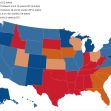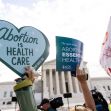The U.S. Supreme Court appeared divided as it revisited the contentious issue of abortion access, weighing Idaho's strict abortion ban against the federal Emergency Medical Treatment and Labor Act (EMTALA), which mandates that patients receive necessary emergency care. The justices heard arguments in an appeal by Idaho officials against a lower court's decision, which found that EMTALA overrides the state's near-total abortion ban in certain medical emergencies.
The Biden administration, having sued Idaho over its abortion legislation, argued for the lower court's ruling to be upheld, emphasizing that federal law requires the provision of essential care that Idaho's law seeks to criminalize. U.S. Solicitor General Elizabeth Prelogar stated that EMTALA sets a "baseline national standard of care" to ensure that urgent health conditions are appropriately addressed, countering Idaho’s restrictive measures.
Idaho's law, which came into effect following the Supreme Court's 2022 decision to overturn Roe v. Wade, bans nearly all abortions, with exceptions only to prevent a mother’s death. This has raised significant concerns about the treatment of women experiencing other severe health complications related to pregnancy. The state’s attorney, Joshua Turner, faced tough questions from the Court's liberal justices about why the state would not allow abortions to prevent serious health consequences other than death.
Justice Elena Kagan highlighted scenarios where an abortion might be necessary to prevent severe permanent health damage, such as loss of reproductive organs, even when the woman's life is not immediately at risk. She noted that such restrictive measures force patients to seek emergency care out of state, which she argued is an untenable situation.
On the conservative side, Justice Brett Kavanaugh explored whether EMTALA was originally intended to address issues like patient dumping rather than specific medical procedures such as abortions. Meanwhile, Justice Samuel Alito raised concerns about the implications of requiring medical interventions like abortions that he argued could conflict with the duty to stabilize the condition of an "unborn child."
The administration’s stance, as articulated by Prelogar, maintains that in many pregnancy emergencies, especially before viability, it is inevitable that the pregnancy will be lost, rendering Idaho’s restrictions unnecessary and harmful as they deny essential treatments.
This Supreme Court case not only revisits the complex legal landscape post-Roe but also tests the boundaries of federal authority over state laws concerning medical care. The outcome could significantly impact how states regulate abortion and how healthcare providers navigate conflicts between state restrictions and federal mandates like EMTALA. The decision will likely hinge on whether a majority of justices view EMTALA as preempting state laws when they restrict necessary medical treatments that federal law aims to protect.
The Preemption Clause in the U.S. Constitution establishes that federal law takes precedence over state laws when there is a conflict between the two. This principle ensures that federal statutes and regulations can effectively govern issues that require uniform national standards, overriding conflicting state regulations. In the case of Idaho's strict abortion ban versus the federal Emergency Medical Treatment and Labor Act (EMTALA), the preemption principle is central to the legal debate. EMTALA mandates that in emergency situations, all patients must receive necessary treatments to stabilize their condition, which could include abortions. If the Supreme Court finds that EMTALA preempts Idaho’s abortion ban, it would mean that the federal requirement to provide life- or health-preserving abortion services in emergencies takes precedence over the state’s restrictions. This would not only affect Idaho but could set a precedent impacting similar laws across other states, underscoring the supremacy of federal law in ensuring critical healthcare protections are uniformly applied across the country.
If the Supreme Court justices were to rule in favor of Idaho's abortion restrictions, their decision could be grounded in several legal and interpretative arguments:
1. State Sovereignty: The justices might emphasize the principle of state sovereignty, which allows states considerable authority to regulate healthcare within their borders. They could argue that matters such as abortion, which involve deep moral and ethical considerations, are best left to the discretion of the states. This perspective respects the traditional role of states as "laboratories of democracy" where diverse policies can be tested according to the values and beliefs of the local population.
2. Narrow Interpretation of EMTALA: The Court could take a narrow view of EMTALA, determining that its primary intent is to prevent patient dumping — the practice of hospitals refusing to treat patients because they lack insurance or the ability to pay. The justices might agree with the argument that EMTALA was not designed to mandate specific treatments such as abortions but rather to ensure that patients are not turned away in emergencies.
3. Lack of Clear Congressional Intent: Another potential basis for a ruling in favor of Idaho could be the absence of clear, explicit congressional intent within EMTALA to override state laws regarding abortion. The justices could determine that if Congress had intended for EMTALA to mandate abortions in certain circumstances, it would have stated this explicitly in the legislation. Without such specificity, the Court might be reluctant to interpret EMTALA as overriding Idaho’s more restrictive law.
4. Protection of Unborn Life: Some justices might focus on the protection of unborn life as a significant interest that Idaho's law seeks to uphold. They could argue that the state law aligns with a legitimate government interest in protecting potential life, which could be seen as equally important, if not more so, than the medical treatment of the mother in certain circumstances as viewed through the lens of the state’s legal and moral framework.
5. Viability and Medical Necessity: The justices might also explore the nuances of medical necessity and viability. They might agree with Idaho's stipulation that abortions are permissible when they are the only means to prevent a mother’s death, considering this a sufficient safeguard for women's health under extreme circumstances without extending to broader health implications, which the state law does not recognize as justification for terminating a pregnancy.
By relying on one or several of these arguments, the Supreme Court could provide a legal justification for upholding Idaho's restrictive abortion law, emphasizing a conservative interpretation of federal powers, the autonomy of states in regulating medical practices, and the protection of potential life.






